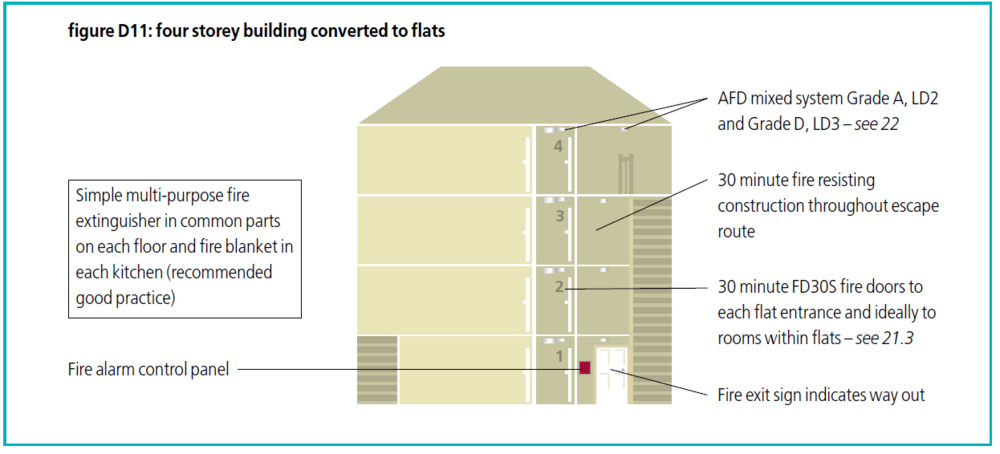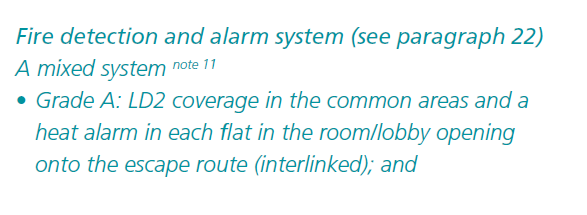-
Posts
2,629 -
Joined
-
Last visited
Everything posted by AnthonyB
-
Before 1991 CP3 Chapter IV Part 1 applied - all it says for chutes is: Refuse chutes should conform to CP 306. The enclosing structure should be of non-combustible materials and should have a fire resistance of not less than one hour or that period required by the Building Regulations for the elements of structure of the building, whichever is the greater. Refuse chute access hoppers should not be in any stairway enclosure or corridor, nor in a stairway protection lobby. Refuse chute enclosures should be ventilated to the open air.
-
Cross corridor door/partition at 30m, ladder remains as alternative exit, restricted access to suit 5/10 persons limit on ladders - there is little that can be done that is proportionate to the risk.
-
I've never heard that one before! It's part of the initial planning for horizontal evacuation and has nothing to do with the stairs - windows aren't part of escape route planning so a fire can still block an exit overloading those remaining even at ground level. As you will see from these two different guides discounting applies in all cases: https://www.twfire.gov.uk/wp-content/uploads/2018/11/Occupancy-Figures-Calculation-Guidance.pdf https://www.bedsfire.gov.uk/Business-safety/Premises-fire-safety/Calculating-Occupancy-Capacities-for-buildings-used-for-Assembly.pdf
-
1991 with the first Approved Document B - I'd have to dig out the older rules to check those but I doubt in was in those.
-
Usually they are either 100mmx100mm square or 80mm diameter based on what is sold ex-stock by suppliers and I've never seen smaller. Letter heights on signs used to be set in fire certificates, but now it's usually based on viewing distances and the signage British Standards. If the standard says 70mm considering the 'point blank range' viewing distance the smallest size in guidance would apply - although 80mm is the smallest sign I've ever seen for sale - the ones on sound like specials or made on a label printer.
-
Many modern LED fittings are dual purpose and can be set up for either maintained or non maintained mode and it sounds like the unit is in maintained mode, although if it wasn't lit when you first installed it I can't see how it's changed just sat there!
-
What sort of building is it and where does your room open onto?
-
-
Whilst it seems illogical I have had supported living & care homes that have received deficiencies notices requiring this very thing, usually resulting in an FD30S door, either kept latched shut when not in use or a free swing closer and in both cases a heat detector. This has only been in places where some residents are severely impaired & the layout has been not the best.
-
Building Regulations are not retrospective. Unless you carry out certain building work requiring Building Regs approval, which might (depending on what you are doing) you need not change them
-
https://files.bregroup.com/research/114408_BRE_Old_Smoke_Detectors_Briefing_Paper.pdf
-
Minimum of 90 degrees opening.
-
Potentially not - depending on the layout of the block and the status of the existing door - is it a fire door to the standard of the time and is it in good order. The official government guidance for existing blocks (& the draft for the new guidance) allows a risk based approach to fire doors such that in certain circumstances original doors may be retained or upgraded. The new guidance, if followed, will have special status under the Fire Safety Act amendments to legislation in England & Wales meaning that if followed it will tend to establish that there was no contravention of legislation meaning that it would be unlikely to be prosecutable except in extreme circumstances. Without seeing the block and the doors (essentially doing an FRA) it's impossible to give a definitive answer, but it's not an automatic 'must replace'
-
No, if the door, wall and associated glazing and partitions are required to be fire rated then all should be, not just some.
-
Detector manufacturers actually have varying ages for warranties on detectors, some far more than 10 years. A BRE study indicated that maximum lifespans shouldn't generally exceed 25 years for most devices which is a fair amount of time. The BS doesn't give a lifespan so as not to be used as a salesman's charter for replacing perfectly functional components.
-
I doubt it will ever have the occupancy to require a panic fastening and as a normal entry/exit point your original thoughts would often be deemed OK
-
Is there no pavement? Is it public or private land? Are there any road and kerb marking indicating any parking restriction? This will help us give you suggestions.
-
Yes, or it could prematurely fail just like the door glazing would without.
-
Your FRA has determined that your conversion requires a full evacuate strategy and this will require a system of mains powered smoke and heat alarms that are linked together, not single station. If you go to here: https://www.safelincs.co.uk/radio-interlinked-smoke-alarms/ and select the Grade D2 filter in the filter options on the left you will see the range of units that are suitable. Radio link is simplest, otherwise all the alarms have to be cable linked. Non interlinked or Grade F devices will not be suitable.
-
If it was a large hotel that doesn't sound appropriate even as a temporary measure, particularly giving out lots of candles! I strongly suggest that as a matter of urgency you contact the Business Fire Safety department of the Fire & Rescue Service that covers where the hotel was.
-

Office buildings, fire rated ceilings, service risers
AnthonyB replied to Bolt's topic in Fire Prevention
Assuming you are in England or Wales you need to look in here: https://www.gov.uk/government/publications/fire-safety-approved-document-b Scotland: https://www.gov.scot/publications/building-standards-technical-handbook-2020-non-domestic/ Service risers usually need to be protected shafts for example -
Are they wired into the Tunstall or wireless linked? Usually you either see Grade D1 third party equipment with a relay base to the system or Tunstall's own Grade F1 wireless detectors (if a newer set up) Could be grade C depending if there is basic fault monitoring. Difficult to say to be honest without looking
-
If it's conscious sedation which is usually the main procedure that is carried out by dentists that requires more than local anaesthetic and the nearest you would get to unconscious outside an operating theatre they will not be asleep (other than possibly very brief periods) but would some need assistance in evacuation as they will be drowsy and relaxed with a lower blood pressure (that could lead to fainting if got up too quickly).Technically speaking they aren't asleep in bed, but additional protection may be needed as either PHE or delayed evacuation may be appropriate. Many practices have stopped doing CS and those that do usually have a dedicated room for it due to the extra equipment and space required - this also limits the need for extra sub compartment provision to one room/section of the practice.
-
Does the restaurant have any doors opening into the residential common stair? If not and the restaurant does have full 60 minutes separation it need not be linked (which is prefered as these premises often have either false alarms or partly/wholly disabled systems!)
-
- refer to current Building Regulations -




